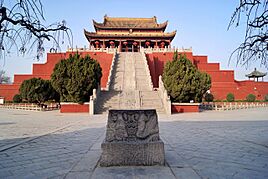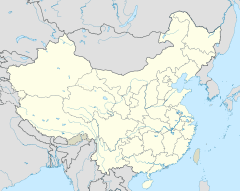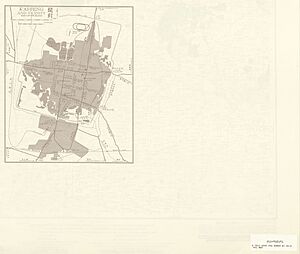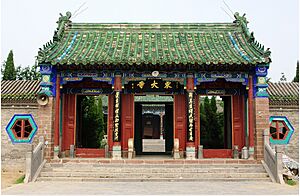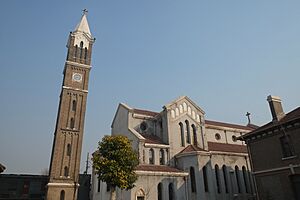Kaifeng facts for kids
Kaifeng (Chinese: 开封; pinyin: Kāifēng) is a big city in the eastern part of Henan province, China. It's known as one of the Eight Ancient Capitals of China. This means it was the capital city of China many times throughout history, especially during the Northern Song dynasty.
In 2020, about 4.8 million people lived in the Kaifeng area. More than 1.7 million of them lived in the main city parts. Kaifeng is located by the southern side of the Yellow River. It's also a major city for science and research, and it's home to a campus of Henan University, which is a very important university in China.
Quick facts for kids
Kaifeng
开封市
|
|
|---|---|
|
Prefecture-level city
|
|
|
Clockwise: Dragon Pavilion, Iron Pagoda, Lu Zhishen Daxiangguo Temple, Songdu Royal Street, Kaifeng Mayor's Mansion
|
|

Location of Kaifeng City jurisdiction in Henan
|
|
| Country | People's Republic of China |
| Province | Henan |
| Municipal seat | Longting District |
| Area | |
| • Prefecture-level city | 6,247 km2 (2,412 sq mi) |
| • Urban | 1,848.5 km2 (713.7 sq mi) |
| • Metro | 1,848.5 km2 (713.7 sq mi) |
| Elevation | 75 m (245 ft) |
| Population
(2020 census)
|
|
| • Prefecture-level city | 4,824,016 |
| • Density | 772.21/km2 (2,000.02/sq mi) |
| • Urban | 1,735,581 |
| • Urban density | 938.913/km2 (2,431.77/sq mi) |
| • Metro | 1,735,581 |
| • Metro density | 938.913/km2 (2,431.77/sq mi) |
| GDP | |
| • Prefecture-level city | CN¥ 175.5 billion US$ 26.4 billion |
| • Per capita | CN¥ 38,619 US$ 5,814 |
| Time zone | UTC+8 (China Standard) |
| Area code(s) | 371 |
| ISO 3166 code | CN-HA-02 |
| Major Nationalities | Han, Hui |
| County-level divisions | 5 |
| License plate prefixes | 豫B |
| Kaifeng | |||||||||||||||||||||||||||
|---|---|---|---|---|---|---|---|---|---|---|---|---|---|---|---|---|---|---|---|---|---|---|---|---|---|---|---|

"Kaifeng" in Simplified (top) and Traditional (bottom) Chinese characters
|
|||||||||||||||||||||||||||
| Simplified Chinese | 开封 | ||||||||||||||||||||||||||
| Traditional Chinese | 開封 | ||||||||||||||||||||||||||
| Literal meaning | "Opening the Border" | ||||||||||||||||||||||||||
|
|||||||||||||||||||||||||||
Contents
Understanding Kaifeng's Name
The name "Kaifeng" means "opening the border." It was given to the area after the Qin dynasty took control of China a long time ago.
Historically, Kaifeng has had several other names:
- Dàliáng
- Biànliáng
- Biànzhōu
- Nánjīng (This was the southern capital for the Jurchen Jin, not the modern city of Nanjing.)
- Dōngjīng
- Biànjīng
The name was originally "Qifeng," but it was changed to "Kaifeng." This was done to avoid using a name that sounded like the name of an emperor, Emperor Jing of Han, which was a common practice back then.
How Kaifeng is Governed
The city of Kaifeng is divided into different areas for easier management. It has five main city districts and four counties.
- Gulou District
- Longting District
- Yuwangtai District
- Xiangfu District
- Shunhe Hui District
- Weishi County
- Qi County
- Tongxu County
- Lankao County
A Look at Kaifeng's Past
Kaifeng has a very long and interesting history. It has been rebuilt many times over the centuries.
Early Beginnings and Growth
Around 364 BC, during the Warring States period, a state called Wei built a capital city here named Daliang. They also built canals to connect local rivers to the Yellow River. Later, when the Qin state conquered Wei, Daliang was destroyed. Only a small market town remained.
During the Han dynasty, the city was rebuilt. It became important when Liu Wu, a prince, made it his capital. He built many new structures and walls. Kaifeng became a place for music, art, and beautiful gardens.
In the early 7th century, Kaifeng became a major trading center. This happened because it was connected to the Grand Canal. Another canal was also built, linking it to western Shandong.
Kaifeng as a Capital City
In 781, during the Tang dynasty, a new city called Bian was built. This city became the capital for several dynasties during the Five Dynasties and Ten Kingdoms period.
In 960, the Song dynasty took over and made Bian its capital. The city grew even more. During the Song dynasty, Kaifeng was known as Dongjing or Bianjing. It was the biggest and richest city in China, with over 400,000 people living there.

In 1049, the Iron Pagoda was built. It is 54.7 meters (179 feet) tall and is the oldest landmark in Kaifeng today. Another pagoda, Po Tower, built in 974, is partly destroyed.
A famous astronomical clock tower was also built by a scientist named Su Song. This clock used water power and had special gears, even before similar inventions in Europe.
Kaifeng was most important in the 11th century. It was a big center for trade and industry. The city had three rings of walls and a population of about 600,000 to 700,000 people. It is believed that Kaifeng was the largest city in the world from 1013 to 1127.
Later History and Rebuilding
In 1127, the city was taken over by invaders called the Jurchen people during the Jingkang Incident. Kaifeng then became part of the Jin dynasty. The Jurchen moved their main capital to Kaifeng in 1214 to escape the Mongols.
In 1232, the Mongols and Song forces attacked Kaifeng. The Mongols captured the city. In 1279, the Mongols took over all of China. Kaifeng became the capital of a province during the Yuan dynasty.
In 1260, the famous traveler Marco Polo visited Kaifeng and wrote about it.
Around the mid-1300s, rebels briefly captured the city. In 1642, the Ming army flooded Kaifeng with water from the Yellow River to stop rebels from taking it. This disaster caused the city to be abandoned again.
Kaifeng was rebuilt in 1662 during the Qing dynasty. Another rebuilding happened in 1843 after a flood in 1841. This shaped the Kaifeng we see today.
For many centuries, Kaifeng was home to the Kaifeng Jews, the oldest Jewish community in China.
On June 6, 1938, the city was taken by the Japanese Imperial Army. Kaifeng was the capital of Henan province until 1954, when the capital moved to Zhengzhou.
Kaifeng's Weather
Kaifeng has a climate with four clear seasons. Winters are cool and mostly dry. Summers are hot and humid. Spring is warm with some rain, and autumn is clear and drier. Most of the rain falls from June to September.
| Climate data for Kaifeng (1991–2020 normals, extremes 1971–2010) | |||||||||||||
|---|---|---|---|---|---|---|---|---|---|---|---|---|---|
| Month | Jan | Feb | Mar | Apr | May | Jun | Jul | Aug | Sep | Oct | Nov | Dec | Year |
| Record high °C (°F) | 19.2 (66.6) |
25.5 (77.9) |
29.9 (85.8) |
36.0 (96.8) |
39.1 (102.4) |
42.5 (108.5) |
40.6 (105.1) |
38.0 (100.4) |
37.4 (99.3) |
34.1 (93.4) |
26.9 (80.4) |
22.2 (72.0) |
42.5 (108.5) |
| Mean daily maximum °C (°F) | 5.4 (41.7) |
9.4 (48.9) |
15.3 (59.5) |
21.8 (71.2) |
27.2 (81.0) |
31.7 (89.1) |
32.0 (89.6) |
30.7 (87.3) |
26.9 (80.4) |
21.6 (70.9) |
13.9 (57.0) |
7.4 (45.3) |
20.3 (68.5) |
| Daily mean °C (°F) | 0.7 (33.3) |
4.2 (39.6) |
9.8 (49.6) |
16.1 (61.0) |
21.7 (71.1) |
26.2 (79.2) |
27.6 (81.7) |
26.3 (79.3) |
21.9 (71.4) |
16.2 (61.2) |
8.8 (47.8) |
2.7 (36.9) |
15.2 (59.3) |
| Mean daily minimum °C (°F) | −2.9 (26.8) |
0.0 (32.0) |
5.2 (41.4) |
11.1 (52.0) |
16.6 (61.9) |
21.3 (70.3) |
23.9 (75.0) |
22.8 (73.0) |
17.8 (64.0) |
11.8 (53.2) |
4.7 (40.5) |
−1.0 (30.2) |
10.9 (51.7) |
| Record low °C (°F) | −15.0 (5.0) |
−14.2 (6.4) |
−7.3 (18.9) |
−1.6 (29.1) |
5.0 (41.0) |
11.3 (52.3) |
15.2 (59.4) |
13.1 (55.6) |
6.0 (42.8) |
−0.2 (31.6) |
−11.7 (10.9) |
−16.0 (3.2) |
−16.0 (3.2) |
| Average precipitation mm (inches) | 8.7 (0.34) |
11.2 (0.44) |
19.2 (0.76) |
38.6 (1.52) |
51.3 (2.02) |
62.1 (2.44) |
157.9 (6.22) |
134.6 (5.30) |
66.3 (2.61) |
31.7 (1.25) |
24.9 (0.98) |
8.8 (0.35) |
615.3 (24.23) |
| Average precipitation days (≥ 0.1 mm) | 3.4 | 4.2 | 4.6 | 5.3 | 6.6 | 7.1 | 10.6 | 9.6 | 7.8 | 5.7 | 4.8 | 3.0 | 72.7 |
| Average snowy days | 4.0 | 3.1 | 1.2 | 0.2 | 0 | 0 | 0 | 0 | 0 | 0 | 1.1 | 2.7 | 12.3 |
| Average relative humidity (%) | 59 | 58 | 57 | 61 | 61 | 62 | 75 | 77 | 72 | 65 | 64 | 61 | 64 |
| Mean monthly sunshine hours | 118.7 | 131.3 | 172.7 | 199.1 | 214.4 | 195.7 | 167.0 | 163.3 | 152.4 | 155.6 | 135.4 | 123.7 | 1,929.3 |
| Percent possible sunshine | 38 | 42 | 46 | 51 | 50 | 45 | 38 | 40 | 41 | 45 | 44 | 41 | 43 |
| Source 1: China Meteorological Administration | |||||||||||||
| Source 2: Weather China | |||||||||||||
Getting Around Kaifeng
Kaifeng has good transportation options, including air, rail, and road.
Air Travel
Kaifeng is about 55 kilometers (34 miles) from Zhengzhou Xinzheng International Airport. This airport is very busy for both passengers and cargo in central China.
You can take a fast train from Kaifeng to the airport. There are many trains each day, and the trip takes about 53 minutes.
Train Travel
Kaifeng railway station is on a major east-west train line. You can easily travel to many cities in China from here, like Beijing, Shanghai, and Xi'an. There are also direct trains to far-off cities like Shenzhen and Harbin.
The Zhengzhou–Kaifeng intercity railway opened in 2014. It connects Kaifeng with Zhengzhou, the provincial capital. Trains on this line can go up to 200 kilometers per hour (124 mph).
Kaifeng North railway station is the main station for high-speed trains. It opened in 2016.
Bus Travel
Kaifeng has four main bus stations. From these stations, you can take buses to nearby counties, other cities in the province, and even to other provinces.
Roads and Highways
Several important highways and national roads pass through Kaifeng, making it easy to travel by car or bus.
 G30 Lianyungang–Khorgas Expressway
G30 Lianyungang–Khorgas Expressway G45 Daqing–Guangzhou Expressway
G45 Daqing–Guangzhou Expressway S82 Zhengzhou–Minquan Expressway
S82 Zhengzhou–Minquan Expressway S83 Lankao–Nanyang Expressway
S83 Lankao–Nanyang Expressway China National Highway 106
China National Highway 106 China National Highway 220
China National Highway 220 China National Highway 310
China National Highway 310
Kaifeng's Culture and Traditions
Different Religions
Kaifeng is known for having the oldest Jewish community in China, called the Kaifeng Jews.
It also has a large Muslim community. Kaifeng is special because it has many women's mosques (nǚsì). The oldest one in China, Wangjia Hutong Women's Mosque, dates back to 1820.
There are also active Christian churches, including the Sacred Heart Cathedral.
Delicious Food
Kaifeng food is a big part of Henan cuisine. The city offers many special dishes, like steamed pies and dumplings. A very famous food is Kaifeng's five-spice bread (wǔxiāng shāobǐng). You can open it up and fill it, like a pita.
In the evenings, Kaifeng's streets become lively with hundreds of food stands. People from nearby cities often come to enjoy the famous night market. The Ma Yu Ching's Bucket Chicken House in Kaifeng is said to be the world's oldest restaurant.
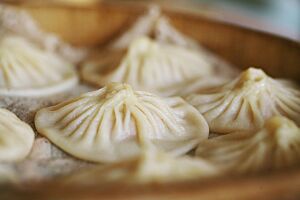
Chrysanthemum Festival
The chrysanthemum is the official flower of Kaifeng. People have been growing chrysanthemums here for over 1600 years. This tradition was very popular during the Song dynasty.
Since 1983, the city has held the China Kaifeng Chrysanthemum Cultural Festival every year. It takes place from October 18 to November 18. During the festival, you can see hundreds of different chrysanthemum types all over the city. Kaifeng is even called the "city of chrysanthemums."
Sports in Kaifeng
Zheng-Kai International Marathon
The China Zheng-Kai International Marathon is a big sports event held every year. "Zheng-Kai" stands for "Zhengzhou-Kaifeng." It's one of the largest sports competitions in central-west China.
The marathon usually happens in late March or early April. The main race takes place along the famous Zhengkai Express Way. When it started in 2007, 5,600 athletes participated. By 2012, nearly 25,000 athletes from many countries had joined the marathon.
Military Presence
Kaifeng is home to the headquarters of the 20th Group Army. This is a part of the People's Liberation Army responsible for defending the Yellow River Plain.
Kaifeng Air Base is a military airfield located in the southern part of Kaifeng City. It is not used for civilian flights.
Images for kids
-
The Iron Pagoda
Sister Cities
Kaifeng has special connections with other cities around the world, called "sister cities."
 Kiryat Motzkin, Israel
Kiryat Motzkin, Israel Omsk, Russia
Omsk, Russia Toda, Japan
Toda, Japan Wichita, United States
Wichita, United States Wingecarribee, Australia
Wingecarribee, Australia Yeongcheon, South Korea
Yeongcheon, South Korea
Colleges and Universities
Kaifeng is an important city for scientific research. It is ranked among the top 200 cities globally for scientific output. The city has a campus of Henan University, which is one of China's key national universities.
Public Universities
- Henan University (河南大学) (started in 1912)
- Kaifeng University (开封大学) (started in 1980)
- Kaifeng Institute of Education (开封教育学院)
- Yellow River Conservancy Technical Institute (黄河水利职业技术学院) (started in 1929)
See also
 In Spanish: Kaifeng para niños
In Spanish: Kaifeng para niños


